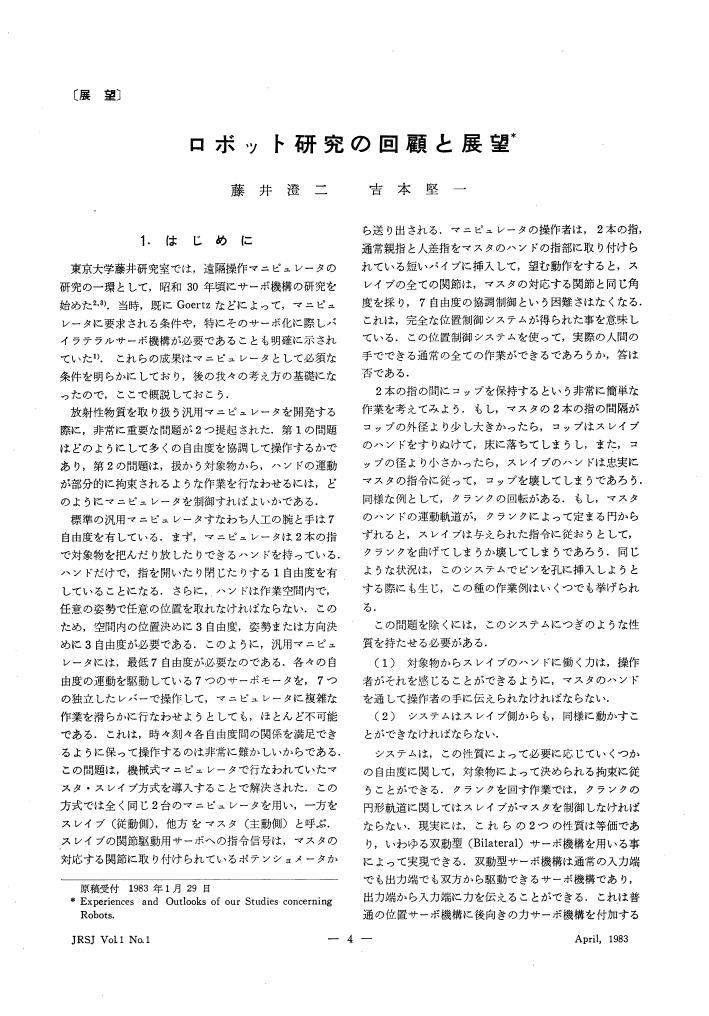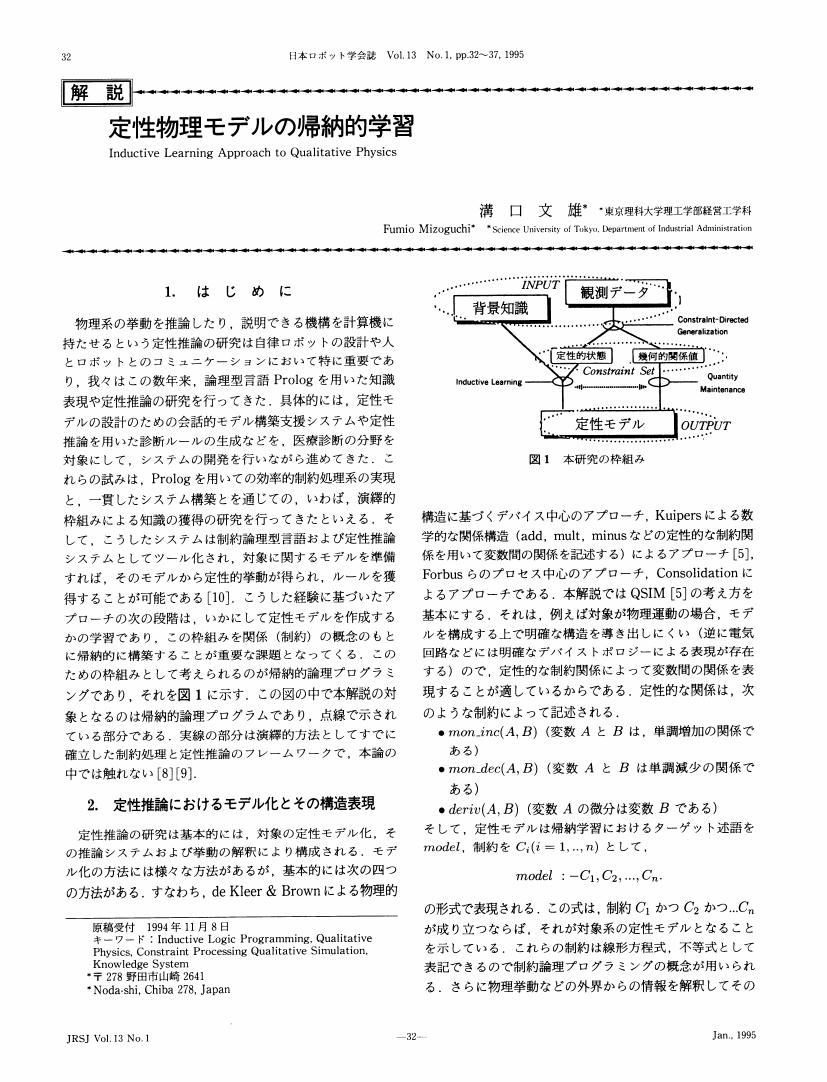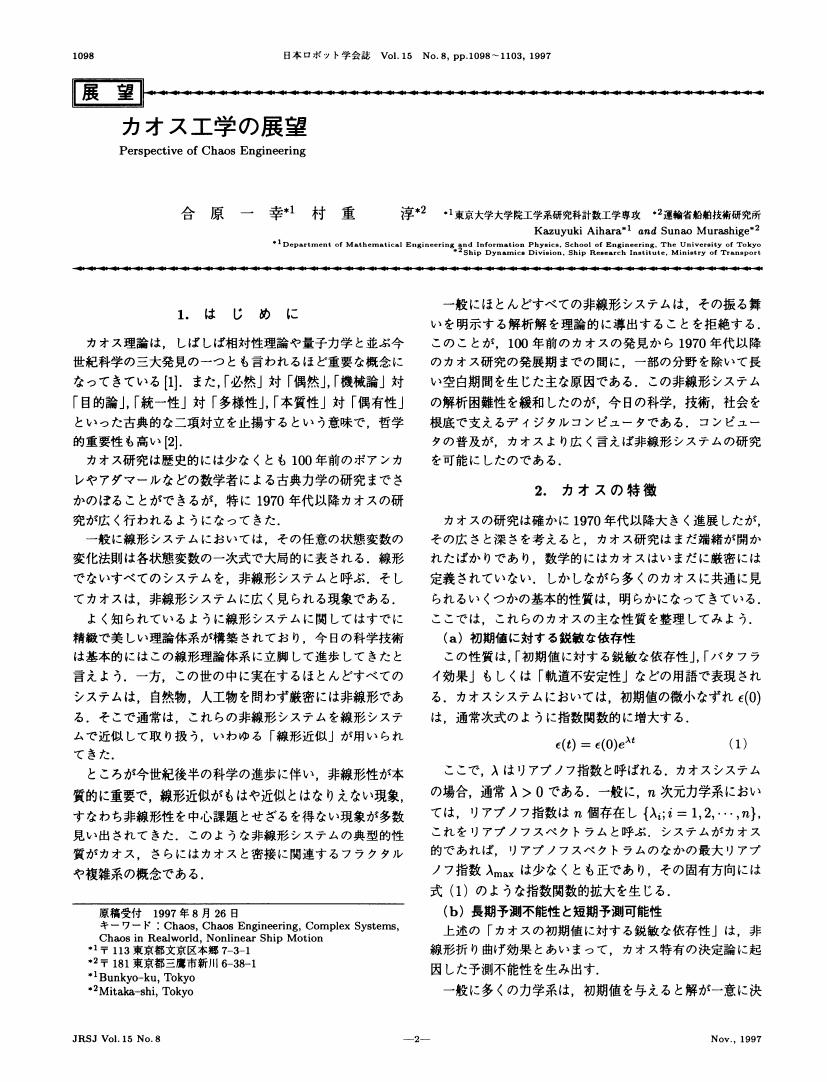2 0 0 0 OA ロボット研究の回顧と展望*
2 0 0 0 OA 定性物理モデルの帰納的学習
- 著者
- 溝口 文雄
- 出版者
- The Robotics Society of Japan
- 雑誌
- 日本ロボット学会誌 (ISSN:02891824)
- 巻号頁・発行日
- vol.13, no.1, pp.32-37, 1995-01-15 (Released:2010-08-25)
- 参考文献数
- 11
- 著者
- 則次 俊郎 安藤 文典 山中 孝司
- 出版者
- The Robotics Society of Japan
- 雑誌
- 日本ロボット学会誌 (ISSN:02891824)
- 巻号頁・発行日
- vol.13, no.1, pp.141-148, 1995-01-15
- 被引用文献数
- 21 13
The number of human requiring the rehabilitation for the fracture of a bone and joint disease caused by the traffic accident and cerebral apoplexy and so on will be increased with the advanced aging society. In the exercise for restoration of function in the rehabilitation, some automatic recovery machines have already been used just for the relatively easy exercise. Moreover, for the complex exercise and evaluation of muscle strength, a multi d.o.f. manipulator is required. However, this kind of robots have not been much developed. Because they require the essential function such as safety and flexibility which are not common in general industrial robots.<BR>In this study, we focus on a rubber artificial muscle and apply 2 d.o.f. manipulator using this actuator to the rehabilitation robot for the exercise for restoration of function. By applying the impedance control scheme containing a two d.o.f. PID control system to a positioning loop, a unified control realizes several exercise motion modes required to the execise and evaluation. Through some experiments of trajectory tracking, compliance, and damping control the satisfactory control performance can be obtained. Further, the proposed control system can realize the all exercise motion modes.
2 0 0 0 OA 人の行動を理解し動作を認識するビジョン技術
- 著者
- 森 武俊
- 出版者
- 一般社団法人 日本ロボット学会
- 雑誌
- 日本ロボット学会誌 (ISSN:02891824)
- 巻号頁・発行日
- vol.27, no.6, pp.617-621, 2009 (Released:2011-11-15)
- 参考文献数
- 30
- 被引用文献数
- 1 2
2 0 0 0 知能の社会性
- 著者
- 大澤 真幸
- 出版者
- The Robotics Society of Japan
- 雑誌
- 日本ロボット学会誌 (ISSN:02891824)
- 巻号頁・発行日
- vol.14, no.4, pp.485-489, 1996-05-15
- 被引用文献数
- 2
2 0 0 0 「午前4時」の戦い!
- 著者
- 大須賀 公一
- 出版者
- The Robotics Society of Japan
- 雑誌
- 日本ロボット学会誌 (ISSN:02891824)
- 巻号頁・発行日
- vol.27, no.2, pp.164-167, 2009-03-15
2 0 0 0 エスノメソドロジーに基づくロボット研究
- 著者
- 久野 義徳
- 出版者
- The Robotics Society of Japan
- 雑誌
- 日本ロボット学会誌 (ISSN:02891824)
- 巻号頁・発行日
- vol.29, no.1, pp.27-30, 2011-01-15
- 被引用文献数
- 1 2
- 著者
- 山崎 敬一
- 出版者
- The Robotics Society of Japan
- 雑誌
- 日本ロボット学会誌 (ISSN:02891824)
- 巻号頁・発行日
- vol.29, no.1, pp.10-13, 2011-01-15
- 被引用文献数
- 1
1 0 0 0 OA カオス工学の展望
- 著者
- 合原 一幸 村重 淳
- 出版者
- The Robotics Society of Japan
- 雑誌
- 日本ロボット学会誌 (ISSN:02891824)
- 巻号頁・発行日
- vol.15, no.8, pp.1098-1103, 1997-11-15 (Released:2010-08-25)
- 参考文献数
- 5
1 0 0 0 OA 道耀先生とあそび心
- 著者
- 仲平 依恵
- 出版者
- 一般社団法人 日本ロボット学会
- 雑誌
- 日本ロボット学会誌 (ISSN:02891824)
- 巻号頁・発行日
- vol.40, no.2, pp.130-132, 2022 (Released:2022-03-17)
- 参考文献数
- 5
- 著者
- 湯口 彰重 豊田 真行 趙 崇貴 吉野 幸一郎 高松 淳 中澤 篤志 小笠原 司
- 出版者
- 一般社団法人 日本ロボット学会
- 雑誌
- 日本ロボット学会誌 (ISSN:02891824)
- 巻号頁・発行日
- vol.41, no.10, pp.893-896, 2023 (Released:2023-12-21)
- 参考文献数
- 13
Analyzing time-series changes of the contact surface by touching is important to elucidate the touching skills of Humanitude as one of the pervasive multimodal comprehensive care methodologies. However, the transparent flat plates to capture contact surfaces used in the previous studies are far from the actual surfaces of care receivers because the surfaces of humans consist of curved shapes. In this paper, we propose a Frustrated Total Internal Reflection (FTIR) sensing system using a transparent curved plate for the purpose to capture contacting state by using a surface more similar to the human body. We evaluate the equivalent performance between data from the proposed FTIR sensing system and an FTIR sensing system using a transparent flat plate by calculating time-series contact areas and the quantitative indices representing theHumanitude's touching motion. Through these experiments, we conclude that the proposed system can obtain the same data quality for the contact areas and the indices as the FTIR system using the flat plate.
1 0 0 0 OA 双輪キャスタ型駆動機構を用いたホロノミック全方向移動ロボット
- 著者
- 和田 正義 高木 昭 森 俊二
- 出版者
- The Robotics Society of Japan
- 雑誌
- 日本ロボット学会誌 (ISSN:02891824)
- 巻号頁・発行日
- vol.18, no.8, pp.1166-1172, 2000-11-15 (Released:2010-08-25)
- 参考文献数
- 11
- 被引用文献数
- 11 16
In this paper, a new wheel mechanism for holonomic and omnidirectional mobile robots is presented. The caster drive technique is one of the feasible solutions to allow a vehicle to have holonomic and omnidirectional mobile capability with standard wheels. The caster drive is applied to a differential drive mechanism. A drive unit equips with two drive wheels driven by individual motors. The rotational stage, driven by the third motor, is mounted on the drive unit with its rotational center locating at the off centered position from the mid point of the two driving wheels. The translational position and velocity of a mobile base are controlled by the differential-drive mechanism executing a caster like behavior. The orientation of the mobile base is controlled by the rotational stage decoupled with the translational motion of the drive unit. The vehicle 3DOF are controlled by the three motors, hence the system includes no over constraint problem. In addition, the drive mechanism is very simple and could be implemented by using a traditional differential-drive mechanism.
1 0 0 0 OA 内臓感覚に基づく感情科学とロボットの設計
- 著者
- 大平 英樹
- 出版者
- 一般社団法人 日本ロボット学会
- 雑誌
- 日本ロボット学会誌 (ISSN:02891824)
- 巻号頁・発行日
- vol.40, no.1, pp.10-13, 2022 (Released:2022-01-17)
- 参考文献数
- 13
- 被引用文献数
- 1
1 0 0 0 OA 大規模言語モデル(LLM)とロボティクス
- 著者
- 持橋 大地
- 出版者
- 一般社団法人 日本ロボット学会
- 雑誌
- 日本ロボット学会誌 (ISSN:02891824)
- 巻号頁・発行日
- vol.40, no.10, pp.863-866, 2022 (Released:2022-12-24)
- 参考文献数
- 11
1 0 0 0 OA サイバネティックヒューマンHRP-4Cの開発 —プロジェクト概要からシステム設計まで—
- 著者
- 金子 健二 金広 文男 森澤 光晴 三浦 郁奈子 中岡 慎一郎 原田 研介 梶田 秀司
- 出版者
- 一般社団法人 日本ロボット学会
- 雑誌
- 日本ロボット学会誌 (ISSN:02891824)
- 巻号頁・発行日
- vol.28, no.7, pp.853-864, 2010 (Released:2012-01-25)
- 参考文献数
- 42
- 被引用文献数
- 7 6
The development of cybernetic human HRP-4C is presented in this paper. The word “Cybernetic Human” is a coinage for us to explain a humanoid robot with a realistic head and a realistic figure of a human being. HRP-4C stands for Humanoid Robotics Platform-4 (Cybernetic human). Standing 158[cm] tall and weighing 43[kg] (including batteries), with the joints and dimensions set to average values for young Japanese females, HRP-4C looks very human-like. This paper introduces the project overview, the design process, mechanical features, and electrical features with specifications of HRP-4C.
1 0 0 0 OA 人間型ロボットのZMPフィードバック制御における制御性能の限界
- 著者
- Napoleon Nazir 中浦 茂樹 三平 満司
- 出版者
- The Robotics Society of Japan
- 雑誌
- 日本ロボット学会誌 (ISSN:02891824)
- 巻号頁・発行日
- vol.22, no.5, pp.656-665, 2004-07-15 (Released:2010-08-25)
- 参考文献数
- 25
- 被引用文献数
- 8 11
This paper presents balance control analysis of humanoid robot based on Zero Moment Point (ZMP) feedback control. The ZMP is often used as a standard evaluation of the stability of humanoid robot. Balance control is performed by controlling ZMP position so that it is always located in convex hull of the foot-support area. To simplify the design of controller, one-mass model which represents lower body part of the humanoid robot model has been commonly applied. However, the one-mass model causes the system becomes non-minimum phase, so that performance limitation is occurred. These disadvantages are attributed to the Waterbed effect in frequency domain and unavoidable undershoot in time domain. Therefore, this paper proposes the ZMP feedback control based on two-mass model, representing lower and upper body part of the humanoid robot. The proposed model results in minimum phase system. Finally, a design of controller based on the proposed model using Linear Quadratic Optimal Control by evaluating output of the system is described and confirmed using simulation.
1 0 0 0 OA ステークホルダ分析を用いた社会実装教育のマネジメント
- 著者
- 津田 尚明
- 出版者
- 一般社団法人 日本ロボット学会
- 雑誌
- 日本ロボット学会誌 (ISSN:02891824)
- 巻号頁・発行日
- vol.35, no.1, pp.55-61, 2016 (Released:2017-02-15)
- 参考文献数
- 18
- 被引用文献数
- 1 2
Participation in collaborative projects is regarded to be one of the necessary activities for universities and colleges. Furthermore, participation of students in such projects is expected to be effective from the view of an engineering design education and social implementation education. Collaborative projects are usually carried out by several stakeholders, and they are required to be managed properly based on their interests. However, they tend to be managed by trial and error, because each stakeholder has different circumstances and different purposes. In this paper, stakeholder analysis was introduced and applied to two social implementation education projects that were carried out in the author's college. One is a management of a lecture where a speaker was invited from another college, and the other is a management of developing a mascot robot for a regional festival. The results from the stakeholder analysis and the author's cognition were compared. As a result, it was confirmed that the stakeholder analysis has a potential capability of a management of projects of social implementation education.
1 0 0 0 OA ロボコンと研究を振り返って
- 著者
- 滝田 好宏
- 出版者
- 一般社団法人 日本ロボット学会
- 雑誌
- 日本ロボット学会誌 (ISSN:02891824)
- 巻号頁・発行日
- vol.38, no.9, pp.789-792, 2020 (Released:2020-11-21)
- 参考文献数
- 9
1 0 0 0 OA ヒトと自律機械の協調作業における主体と責任
- 著者
- 葭田 貴子
- 出版者
- 一般社団法人 日本ロボット学会
- 雑誌
- 日本ロボット学会誌 (ISSN:02891824)
- 巻号頁・発行日
- vol.38, no.1, pp.23-27, 2020 (Released:2020-01-16)
- 参考文献数
- 18
- 被引用文献数
- 1
1 0 0 0 OA 柔軟全周囲クローラ(FMT) — 無限軌道と脊椎構造を用いた新しい移動機構 —
- 著者
- 衣笠 哲也 大谷 勇太 土師 貴史 吉田 浩治 大須賀 公一 天野 久徳
- 出版者
- 一般社団法人 日本ロボット学会
- 雑誌
- 日本ロボット学会誌 (ISSN:02891824)
- 巻号頁・発行日
- vol.27, no.1, pp.107-114, 2009 (Released:2011-11-15)
- 参考文献数
- 31
- 被引用文献数
- 8 5
In the past decade, search type rescue robots have been focused on. Most robots took “linked mobile track” type such as snakes, so as to obtain high quality against unknown irregular surfaces. However the linked mobile track has some joints and sometimes they shut in some debris and stuck on it. In addition, many links increase total weight of robots and control complexity. In the paper, we propose a new type mobile mechanism, Flexible Mono-Tread Mobile Track (FMT) and develop a prototype called “Rescue mobile Track No.2 (RT02) WORMY”. The prototype consists of a flexible chain and a vertebrae like structure. Moreover, we investigate its performance against the irregular surfaces.



